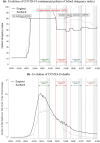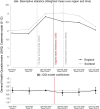Impact of COVID-19 lockdowns on mental health: Evidence from a quasi-natural experiment in England and Scotland
- PMID: 34773325
- PMCID: PMC8646947
- DOI: 10.1002/hec.4453
Impact of COVID-19 lockdowns on mental health: Evidence from a quasi-natural experiment in England and Scotland
Abstract
The COVID-19 pandemic has been associated with worsening mental health but it is unclear whether this is a direct consequence of containment measures, like "Stay at Home" orders, or due to other considerations, such as fear and uncertainty about becoming infected. It is also unclear how responsive mental health is to a changing situation. Exploiting the different policy responses to COVID-19 in England and Scotland and using a difference-in-difference analysis, we show that easing lockdown measures rapidly improves mental health. The results were driven by individuals with lower socioeconomic position, in terms of education or financial situation, who benefited more from the end of the strict lockdown, whereas they suffered a larger decline in mental health where the lockdown was extended. Overall, mental health appears to be more sensitive to the imposition of containment policies than to the evolution of the pandemic itself. As lockdown measures may continue to be necessary in the future, further efforts (both financial and mental health support) are required to minimize the consequences of COVID-19 containment policies for mental health.
Keywords: COVID-19; health; health inequality; lockdown; mental health.
© 2021 The Authors. Health Economics published by John Wiley & Sons Ltd.
Conflict of interest statement
The authors declare no conflict of interest.
Figures




References
-
- Abadie, A. , Athey, S. , Imbens, G. W. , & Wooldridge, J. (2017). When should you adjust standard errors for clustering?. National Bureau of Economic Research.
-
- Arendt, F. , Markiewitz, A. , Mestas, M. , & Scherr, S. (2020). COVID‐19 pandemic, government responses, and public mental health: Investigating consequences through crisis hotline calls in two countries. Social Science & Medicine, 265, 113532. - PubMed
-
- Armbruster, S. , & Klotzbücher, V. (2020). Lost in lockdown? COVID‐19, social distancing, and mental health in Germany. Diskussionsbeiträge.
-
- Banks, J. , & Xu, X. (2020). The mental health effects of the first two months of lockdown and social distancing during the Covid‐19 pandemic in the UK [working paper]. IFS.
Publication types
MeSH terms
Grants and funding
LinkOut - more resources
Full Text Sources
Medical
Research Materials

